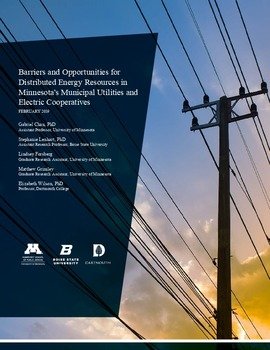Barriers and Opportunities for Distributed Energy Resources in Minnesota's Municipal Utilities and Electric Cooperatives
Recommended Citation
Chan, Gabriel, Stephanie Lenhart, Lindsey Forsberg, Matthew Grimley, and Elizabeth Wilson. 2019. Barriers and Opportunities for Distributed Energy Resources in Minnesota’s Municipal Utilities and Electric Cooperatives. University of Minnesota Center for Science, Technology, and Environmental Policy; Boise State University Energy Policy Institute; Dartmouth University Arthur L. Irving Institute for Energy and Society.
Abstract
Minnesota has a complex electricity system, with more than 170 electric utilities, the third highest total of any state in the country. Minnesota has taken numerous steps in the past decade to become more efficient and better able to incorporate more renewable resources. While investor-owned utilities have received significant policy attention, the vast majority of the state’s land-area and over one-third of the state’s electricity is delivered by nonprofit, locally controlled utilities: municipal utilities (munis) and rural electric cooperatives (co-ops).
This report summarizes our findings from a two-year research project to investigate the landscape of Minnesota’s munis and co-ops. Our focus is on how these utilities are confronting new challenges and opportunities emerging from smaller-scale, often-more sustainable distributed energy resources (DERs), such as rooftop solar, community shared solar, LED light bulbs, controllable water heaters, and electric vehicles. Because munis and co-ops were built to serve their communities through participatory governance and local authority, they make decisions in fundamentally different ways than for-profit utilities. These decisions matter in the context of emerging technologies as actors across the state aim to create a fair and sustainable energy system for all members of the public.

